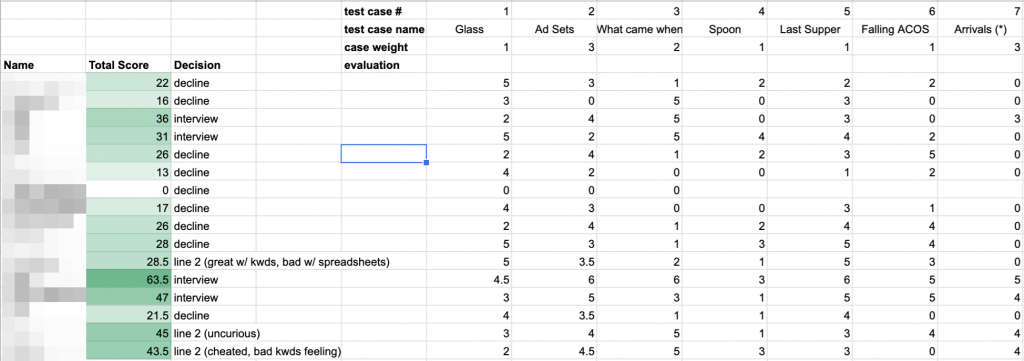
We hear this mantra all the time: hire A-players. But who is an A-player? We certainly wanted to hire the best people we can find, but the traditional image of an “A-player” was too vague.
“A-players own both good and bad outcomes. […] A-players try something new or different to correct their course. […] A-players excite and motivate the people around them […] A-players work to understand the ins and outs of their business. […]” – Inc.com
Ok, any word about the professional skills? When choosing a surgeon, would your main criteria be if he “owns both good and bad outcomes”, “tries something new or different”, “excites and motivates people”, and “works to understand the ins and outs”?
I personally would research into how many similar operations this surgeon has handled, what were the benefits (increase in life expectancy), and the side effects (death or other damages), giving a larger weight to the downside risk.
Here is another definition of an A-player, this time from Rick Crossland, the author of the book “The A Player”:
“An employee who is in the top 10 percent of their profession on an industry-wide basis for the salary paid.” – Recruiter.com
It is a circular definition: “a top player is a person who is in the top X percent.”
The other definitions from this author are of the same merit: “A person on your team whom you would enthusiastically rehire”. This insight is equivalent to the statement that you should hire people who satisfy or exceed your expectations.
While we highly respect these major business thinkers and media, we needed some practical guidance beyond self-referring definitions.
We believe the laws of business are similar to the laws of physics: we can experiment, fine-tune and empirically figure out what works and what doesn’t. Then we can prepare a model which explains our observations, is falsifiable, and has good enough predictive power.
We developed a set of principles to recognize, evaluate and hire the top performers.
1. Interview and test entry-level employees with the same diligence you test the top managers (with an adjustment to allow scalability)

Entry-level employees are the ones who will become our top managers in the future. Most of our managers are promoted from within. Most promotions happen fast – usually, we would conceive a new project or a new department. We would look at our team, and choose the best person, given he has the desire and ability to manage others. This way we get managers fast, with a proper operating system (our values, the context, and certain respect and trust). They can hit the ground running.
Therefore, some of our employees eventually will be promoted. and in the worst case they are the worst performers. The quality of people at the top of the company is defined by the quality of people at the first stage of the funnel.
Hiring is dangerous, as once you hire someone, it’s hard to fire him. Hiring can be done momentarily, but firing even a totally toxic employee requires, at least, some legitimate review process. And it is almost impossible to (legitimately) fire someone who performs his job at 6/10 level – not excellently, but not that bad to be fired on the spot. These 6/10 people can eventually become top managers. I can imagine 7/10-ers will promote them, who were promoted by 8/10-ers, who were promoted in turn by 9/10-ers, etc. If they can become managers, they will.
A company that hires top-50% performers (which is not too bad) is a very different type of a company that hires only the top-5% performers. The first one’s top managers and strategists are, in the best case, the best of the average guys, who stayed in the company for long enough. The second company’s top managers and strategies are, in the worst case, people who belonged to the top-5% performers group. And in the best case, when the internal selection mechanisms work well, they are the best out of the best 5%.
2. Before hiring, define the specific types of situations that the person will have to solve and measure how well the person solves them

Essentially, any occupation means solving cases brought upon someone to achieve the desired outcomes.
Surgeons solve problems with body textures to improve the patient’s health. Software developers solve the absence of pre-made code modules which would perform the needed operations. The drivers have to deal with the car management and traffic situation while complying with the regulations to bring their vehicle from point A to point B.
We break down everyone’s job into its basic parts and define test tasks that the person can perform so that we can estimate both his outcomes and his logic. We also develop a weighted set of criteria to estimate the outcomes he/she achieved with each test case.
Sometimes it takes certain organizational and acting skills, for example, to organize a situation to test the conflict-resolution skills. The more complex the job, the harder is it to estimate how well does the person handles the cases brought upon her. You can be a great trader, but you will have periods when there is no volatility and you will make no money. You can be the best surgeon and your patient dies. And at some jobs, it’s impossible to even create a test task – as in the example with the surgeon.
In this case, we shall find the best available proxies for each hard and soft skill that the person should have, and test these proxies.
We also stress-test our list of skills/personal qualities/strengths with competent people. Maybe some tasks don’t really test the required skills? Or maybe something is redundant? We adjust accordingly.
3. Rank all the candidates on a numeric scale, but also leave space for unstructured comments and gut feeling

We’d come up with a weight for each criterion for each test task, and then we’ll estimate the candidates and put everyone on a scale, say, from 1 to 100. Same for the interviews. What questions are we going to ask, and how are we going to evaluate the answers? We crash down on any cargo cults within our team. We stopped asking questions like “where do you see yourself in 10 years”, and the likes unless we know how specifically to evaluate and rate the answer. Of course, some questions are asked to just understand the person better and his/her capabilities.

The evaluation matrix of candidates for an entry-level position
Additionally, we’ll look at the CVs and interview the top 30% of the applicants by the test tasks; sometimes more. We do it just to make sure we don’t miss out on great candidates if our testing and weighting system is too wrong. Sometimes, we’ll see a candidate who has something that plays overwhelmingly in his favor. But it’s not on our evaluation criteria list. Then we work to define this thing, measure it, and incorporate it into our set of criteria.
The gut feeling matters too. However, only if that gut belongs to a person who has looked at 100+ candidates, observed their performance, and has a proven track record in using his gut feeling (proven track record means: he had a bad gut feeling for the candidates who were eventually fired, and a good feeling for the candidates who were the top performers).
4. Improve your hiring process based on the defects of the new hires

Everyone has certain defects. I have them, you have them (ask your teammates). No one is created perfectly to perform his job. Day to day, we observe how people handle their responsibilities and reveal what are their strengths and weaknesses
Sometimes we are surprised by the qualities the person demonstrates, but which we didn’t see during the testing phase. For example, a compliance officer we hired can be inattentive to details.
We use this information to improve our hiring process – the test tasks, the proxies, the evaluation criteria so that when hiring for similar positions in the future, we can evaluate and rank the candidates better.
5. If you come across a great talent, a top-3% – top-1% performer, do everything you can (assuming it’s ecological to your other objectives) to hire and keep that person

If you hire the top-3% performers, your competitors have to work with the bottom 97%. Better people create better innovations, processes, as well as attract and hire better people too. If you vacuum the market, the competitors will have no one to work with. However, the strength of this effect depends on how many players you have in your industry, and how large is the market that you and your competitors hire from.
Conclusion
This set of principles is imperfect, incomplete, and largely is a work in progress, just like our entire company. By the time you read it, it will be already outdated, as someone has already updated our SOPs so they will reflect the reality even better.
These principles work well enough for our company within our current reality. But there’s no guarantee you can apply them ‘as is’ and get as good results as we get.
Therefore I do not advise you to apply them straightforwardly in your company. I encourage you to reflect on what is your approach to hiring, systematically define your principles to it, and stress-test them with other trustworthy people who achieved great results and have good explanations on how they did it.
I also welcome you to share your reflections and disagreements.
Credits to: Ray Dalio and Andy Grove, whose works largely impacted our management approach.